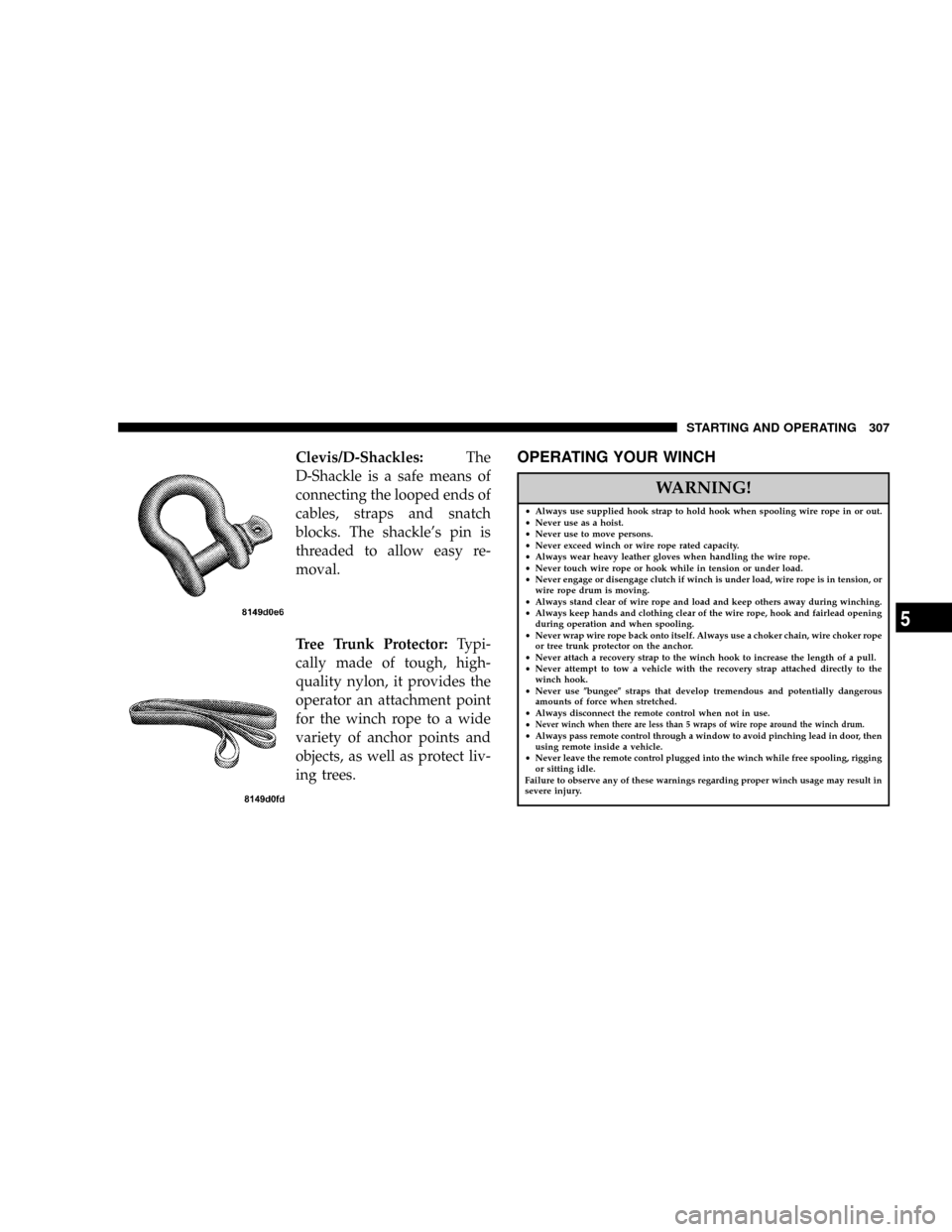window DODGE RAM 2500 POWER WAGON 2008 3.G Owner's Guide
[x] Cancel search | Manufacturer: DODGE, Model Year: 2008, Model line: RAM 2500 POWER WAGON, Model: DODGE RAM 2500 POWER WAGON 2008 3.GPages: 504, PDF Size: 8.17 MB
Page 250 of 504

Regular cleaning of the inside of the windows with a
non-filming cleaning solution (vinegar and water works
very well) will help prevent contaminates (cigarette
smoke, perfumes, etc.) from sticking to the windows.
Contaminates increase the rate of window fogging.
Summer Operation
Air conditioned vehicles must be protected with a high
quality antifreeze coolant during summer to provide
proper corrosion protection and to raise the boiling point
of the coolant for protection against overheating. A 50 %
concentration is recommended. Refer to Recommended
Fluids and Genuine Parts for the proper coolant type.
When using the air conditioner in extremely heavy traffic
in hot weather especially when towing a trailer, addi-
tional engine cooling may be required. If this situation is
encountered, operate the transmission in a lower gear to
increase engine RPM, coolant flow and fan speed. When
stopped in heavy traffic, it may be necessary to shift intoNEUTRAL and depress the accelerator slightly for fast
idle operation to increase coolant flow and fan speed.
NOTE:On models equipped with Diesel engines, the
idle speed will automatically increase to 1000 rpm at
elevated coolant temperatures to improve engine cooling.
Your air conditioning system is also equipped with an
automatic recirculation system. When the system senses
a heavy load or high heat conditions, it may use partial
Recirculation A/C mode to provide additional comfort.
Winter Operation
When operating the system during the winter months,
make sure the air intake, located directly in front of the
windshield, is free of ice, slush, snow, or other obstruc-
tions.
250 UNDERSTANDING YOUR INSTRUMENT PANEL
Page 307 of 504

Clevis/D-Shackles:The
D-Shackle is a safe means of
connecting the looped ends of
cables, straps and snatch
blocks. The shackle's pin is
threaded to allow easy re-
moval.
Tree Trunk Protector:Typi-
cally made of tough, high-
quality nylon, it provides the
operator an attachment point
for the winch rope to a wide
variety of anchor points and
objects, as well as protect liv-
ing trees.OPERATING YOUR WINCH
WARNING!
²Always use supplied hook strap to hold hook when spooling wire rope in or out.
²Never use as a hoist.
²Never use to move persons.
²Never exceed winch or wire rope rated capacity.
²Always wear heavy leather gloves when handling the wire rope.
²Never touch wire rope or hook while in tension or under load.
²Never engage or disengage clutch if winch is under load, wire rope is in tension, or
wire rope drum is moving.
²Always stand clear of wire rope and load and keep others away during winching.
²Always keep hands and clothing clear of the wire rope, hook and fairlead opening
during operation and when spooling.
²Never wrap wire rope back onto itself. Always use a choker chain, wire choker rope
or tree trunk protector on the anchor.
²Never attach a recovery strap to the winch hook to increase the length of a pull.
²Never attempt to tow a vehicle with the recovery strap attached directly to the
winch hook.
²Never use(bungee(straps that develop tremendous and potentially dangerous
amounts of force when stretched.
²Always disconnect the remote control when not in use.
²
Never winch when there are less than 5 wraps of wire rope around the winch drum.²Always pass remote control through a window to avoid pinching lead in door, then
using remote inside a vehicle.
²Never leave the remote control plugged into the winch while free spooling, rigging
or sitting idle.
Failure to observe any of these warnings regarding proper winch usage may result in
severe injury.
STARTING AND OPERATING 307
5
Page 313 of 504

9. Connect the remote control to the winch control box,
located behind the front bumper. Be careful not to let the
remote control cord dangle in front of the winch. If you
choose to control the winch from inside your vehicle,
always pass the remote through a window to avoid
pinching the cord in the door. Always disconnect the
remote control when not in use.10. Put wire rope under tension. Using the remote con-
trol switch, slowly wind the wire rope until no slack
remains. Once the wire rope is under tension, stand well
clear and never step over it.
11. Check your anchor. Make sure all connections are
secured and free of debris before continuing with the
winching procedure.
STARTING AND OPERATING 313
5
Page 356 of 504

the ignition key is cycled, this sequence will repeat,
providing the system fault still exists. A system fault can
occur by any of the following scenarios:
1. Signal interference due to electronic devices or driving
next to facilities emitting the same Radio Frequencies as
the TPM sensors.
2. Installing aftermarket window tinting that affects ra-
dio wave signals.
3. Accumulation of snow or ice around the wheels or
wheel housings.
4. Using tire chains on the vehicle.
5. Using wheels/tires not equipped with TPM sensors.
6. Loss of communication with the trigger modules or
tire pressure monitoring sensors.
NOTE: Your vehicle is equipped with a non-matching
full size spare wheel and tire assembly.1. This spare tire does not have a tire pressure monitor-
ing sensor. Therefore, the TPMS will not monitor the tire
pressure in the spare tire.
2. If you install the full size spare tire in place of a road
tire that has a pressure below the low-pressure warning
limit, upon the next ignition key cycle, a chime will
sound and the TPM Telltale Light will still turn ON due
to the low tire.
3. However, after driving the vehicle for up to 10 min-
utes above 15 mph (25 km/h), the TPM Telltale Light will
flash on and off for 75 seconds and then remain on solid.
4. For each subsequent ignition key cycle, a chime will
sound and the TPM Telltale Light will flash on and off for
75 seconds and then remain on solid.
5. Once you repair or replace the original road tire, and
reinstall it on the vehicle in place of the full size spare tire,
the TPMS will update automatically and the TPM Telltale
356 STARTING AND OPERATING
Page 361 of 504

²The use of fuel additives which are now being sold as
octane enhancers is not recommended. Many of these
products contain high concentrations of methanol.
Fuel system damage or vehicle performance problems
resulting from the use of such fuels or additives is not
the responsibility of the manufacturer.
NOTE:Intentional tampering with emissions control
systems can result in civil penalties being assessed
against you.
Carbon Monoxide Warnings
WARNING!
Carbon monoxide (CO) in exhaust gases is deadly.
Follow the precautions below to prevent carbon
monoxide poisoning:
²Do not inhale exhaust gases. They contain carbon
monoxide, a colorless and odorless gas which can kill.
Never run the engine in a closed area, such as a
garage, and never sit in a parked vehicle with the
engine running for an extended period. If the vehicle is
stopped in an open area with the engine running for
more than a short period, adjust the ventilation system
to force fresh, outside air into the vehicle.
²Guard against carbon monoxide with proper mainte-
nance. Have the exhaust system inspected every time
the vehicle is raised. Have any abnormal conditions
repaired promptly. Until repaired, drive with all side
windows fully open.
²Keep the liftgate closed when driving your vehicle to
prevent carbon monoxide and other poisonous ex-
haust gases from entering the vehicle.
STARTING AND OPERATING 361
5
Page 446 of 504

can act as an abrasive and damage the leather upholstery
and should be removed promptly with a damp cloth.
Stubborn soils can be removed easily with a soft cloth
and MopartTotal Clean. Care should be taken to avoid
soaking your leather upholstery with any liquid. Please
do not use polishes, oils, cleaning fluids, solvents, deter-
gents, or ammonia based cleaners to clean your leather
upholstery. Application of a leather conditioner is not
required to maintain the original condition.
WARNING!
Do not use volatile solvents for cleaning purposes.
Many are potentially flammable, and if used in
closed areas they may cause respiratory harm.
Glass Surfaces
All glass surfaces should be cleaned on a regular basis
with MopartGlass Cleaner or any commercialhousehold-type glass cleaner. Never use an abrasive type
cleaner. Use caution when cleaning the inside rear win-
dow equipped with electric defrosters or the right rear
quarter window equipped with the radio antenna. Do
not use scrapers or other sharp instruments which may
scratch the elements. When cleaning the rear view mirror,
spray cleaner on the towel or rag that you are using. Do
not spray cleaner directly on the mirror.
Cleaning Plastic Instrument Cluster Lenses
The lenses in front of the instruments in this vehicle are
molded in clear plastic. When cleaning the lenses, care
must be taken to avoid scratching the plastic.
1. Clean with a wet soft rag. A mild soap solution may be
used, but do not use high alcohol content or abrasive
cleaners. If soap is used, wipe clean with a clean damp
rag.
2. Dry with a soft tissue.
446 MAINTAINING YOUR VEHICLE
Page 452 of 504

VEHICLE STORAGE
If you are storing your vehicle for more than 21 days, we
recommend that you take the following steps to mini-
mize the drain on your vehicle's battery:
²Disconnect the Ignition-Off Draw fuse (I.O.D.) fuse
located in the Integrated Power Module, located in the
engine compartment. The I.O.D. cavity includes a
snap-in retainer that allows the fuse to be discon-
nected, without removing it from the fuse block.
²The electronic shift transfer case should be placed in
the 4HI mode and kept in this position to minimize the
battery drain.
²As an alternative to the above steps you may, discon-
nect the negative cables from both batteries.
²Anytime you store your vehicle, or keep it out of
service (i.e. vacation) for two weeks or more, run the
air conditioning system at idle for about five minutesin the fresh air and high blower setting. This will
insure adequate system lubrication to minimize the
possibility of compressor damage when the system is
started again.
NOTE:When reinstalling the IOD fuse push firmly until
fully seated, the gages in the Instrument Cluster will do
a full sweep, when the ignition key is cycled to RUN. This
is a normal condition.
NOTE:When the vehicle is shipped from the factory,
the IOD fuse is in the up, or extracted position. If the
radio, interior lamps, keyless entry, or other features do
not work with the key off, check the position of the fuse
(or check to see if the fuse is blown) to ensure that it is
fully seated. When the IOD fuse is extracted, the instru-
ment cluster, in the odometer window, will display9NO
FUSE
452 MAINTAINING YOUR VEHICLE
Page 489 of 504

Cruise Control (Speed Control).............. 138
Cup Holder............................ 162
Customer Assistance..................... 476
Data Recorder, Event...................... 59
Daytime Running Lights................... 131
Dealer Service.......................... 412
Defroster, Rear Window.................92,165
Defroster, Windshield................77,240,243
Delay (Intermittent) Wipers................. 135
Differential............................. 84
Differential, Limited-Slip.................. 275
Digital Video Disc (DVD) Player.............. 84
Dipsticks
Automatic Transmission................. 436
Power Steering........................ 421
Disc Brakes............................ 432
Disposal
Antifreeze (Engine Coolant)............... 429Door Locks............................. 27
Door Opener, Garage..................... 150
Drive Belts............................ 416
Driving
Off-Pavement......................... 281
Off-Road............................ 281
Electric Rear Window Defrost.............92,165
Electrical Power Outlets................... 159
Electronic Speed Control (Cruise Control)...... 138
Emergency Brake........................ 321
Emergency, In Case of
Freeing Vehicle When Stuck............... 402
Hazard Warning Flasher................. 390
Jacking............................. 393
Jump Starting......................... 399
Tow Hooks.......................... 402
Towing............................. 403
INDEX 489
10
Page 496 of 504

Onboard Diagnostic System..............409,410
Opener, Garage Door (HomeLinkt) ........... 150
Operating Precautions.................... 409
Outside Rearview Mirrors.................. 90
Overdrive............................. 265
Overdrive OFF Switch.................... 265
Overhead Console....................142,143
Overhead Travel Information Center.......... 143
Owner's Manual (Operator Manual).......... 480
Parking Brake.......................... 321
Passenger Airbag On/Off Switch............. 55
Passing Light........................... 134
Pets.................................. 74
Pets, Transporting........................ 74
Phone, Cellular.......................... 93
Phone, Hands-Free (UConnectŸ)............. 93
Pickup Box............................ 169Placard, Tire and Loading Information......... 331
Positive Crankcase Valve.................. 419
Power
Distribution Center (Fuses)............... 447
Door Locks........................... 28
Mirrors.............................. 91
Outlet (Auxiliary Electrical Outlet).......... 159
Seats............................... 124
Sliding Rear Window................... 165
Steering..........................325,421
Sunroof............................. 156
Windows............................. 32
Power Steering Fluid..................... 466
Power Wagon Features..................... 84
Pregnant Women and Seat Belts.............. 46
Pretensioners
Seat Belts............................. 45
496 INDEX
Page 497 of 504

Radial Ply Tires......................... 338
Radiator Cap (Coolant Pressure Cap).......427,429
Radio Broadcast Signals................... 191
Radio, Navigation....................... 227
Radio Operation...................192,200,213
Radio Remote Controls.................... 235
Radio, Satellite.......................228,231
Radio (Sound Systems)..............192,200,213
Ramp Travel Index....................... 282
Rear Axle (Differential).................... 434
Rear Wheel Bearings..................... 439
Rear Window Features.................... 165
Rear Window, Sliding..................... 166
Reclining Front Seats..................... 122
Recorder, Event Data...................... 59
Recreational Towing...................... 384
Shifting into Transfer Case Neutral (N)....... 384
Shifting out of Transfer Case Neutral (N)..... 386Reformulated Gasoline.................... 358
Refrigerant............................ 421
Reminder, Seat Belt....................... 45
Remote Keyless Entry (RKE)................. 21
Remote Sound System (Radio) Controls........ 235
Remote Starting System.................... 25
Replacement Keys........................ 16
Replacement Tires....................... 342
Reporting Safety Defects................... 479
Resetting Oil Change Indicator.............. 183
Restraint, Head......................... 122
Restraints, Child.......................61,68
Restraints, Occupant...................... 34
Ride Height............................ 85
Rotation, Tires.......................... 346
Safety Checks Inside Vehicle................. 77
Safety Checks Outside Vehicle............... 78
INDEX 497
10